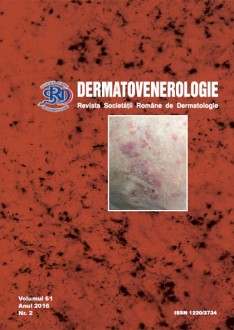Androgenetic alopecia (balding) is a frequent condition in men aged over 40 (with an onset in the second decade of life) but also in women at the post-menopausal period or with hyperandrogenism. Its ethiopathogeny involves
genetic and hormonal factors (androgens) but also seborrhea. (2)
Clinically, in men, alopecia starts in the frontotemporal region of the scalp and spreads to the vertex (2), while in women rarefaction of the hair in the coronal area of the scalp can be observed. (1)
The patients with early androgenetic alopecia often present altered serum levels of hormons. (10)
Scalp dermoscopy or tricoscopy is a valuable and noninvasive technique used in the evaluation of alopecic patients which allows the visualization of the hair and scalp at magnified dimensions. (3)
Histopathological aspects are characteristic and are essential for the differential diagnosis of other alopecias. (1)
The main agent used systemic in androgenetic alopecia in men is Finasteride. In women, there may also be used
combinations of ethynilestradiol 25 micrograms and Cyproterone acetate 2-5 miligrams (between days 5-25 of the menstruation). (2). Sometimes, supplements such as cysteine, methionine, zinc, calcium, vitamins, which simulate hair growth,may also be used.
The topical treatment includes minoxidil 2% or 5%, dermatocorticosteroids (16), adenosine (13), lotions with caffeine, vitamin B6, zinc pyrithione, silicium, viniferin, AHA and anti-seborrheic shampoos or lotions. (2)
Low-frequency laser therapy (18), polyamide hair implants (15) , hair grafts (1) or PRP (platelet rich plasma)
(22) may also be used.
General reviews
UPDATES IN ETHIOPATHOGENY AND TREATMENT OF ANDROGENETIC ALOPECIA


